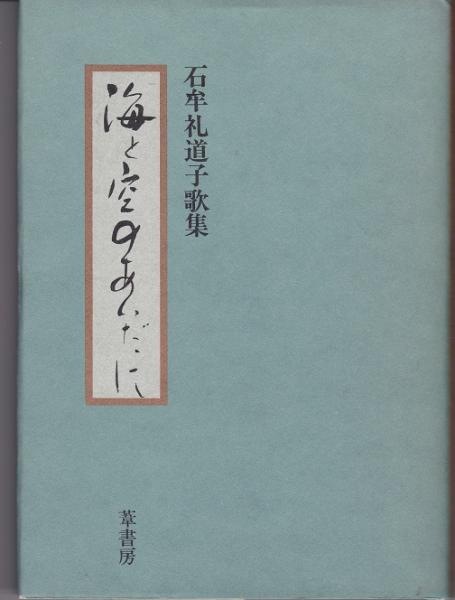The seventh Ishimure Michiko Reading Group was held via Zoom on September 28, 2020 at 3 p.m. Masahisa Suzuki (The University of Tokyo), Shiho Maeshima (The University of Tokyo), Yusuke Yamada (Daito Bunka University), Maki Sato (The University of Tokyo), Hanako Takayama (The University of Tokyo), Akihiro Miyata (The University of Tokyo), Ryohei Tatebe (The University of Tokyo), and Mizuki Uno (The University of Tokyo) in the Session. This session was the last in which we read the second part of Kugai Jodo. Mizuki Uno was in charge of presentation, and she chose the following supplemental articles in order to examine the transition of imagery between sea and sky in Ishimure’s early tanka creation and the writing of the second part of the novel.
・井上洋子「「ゆき女きき書」成立考――石牟礼道子とフェミニズム」(佐藤泰至編『フェミニズムあるいはフェミニズム以後』笠間書院、1991年)
・岩淵宏子「表象としての〈水俣病〉――石牟礼道子の世界」『社会文学』15号、2001年)
Both of the articles discussed in this session carefully examined the writing process of the first part of Kugai Jodo. Especially, the former points out the influence of Tanigawa and Itsue Takamure’s perspectives on women’s history on Ishimure’s thinking and style in writing Kugai Jodo, Paradise in the Sea of Sorrow. The latter article evaluates Kugai Jodo itself, providing an incisive look at the root of the disease of modern industry through a poetic sensibility via the image of Minamata as a source of life prior to destruction caused by modernization in Tsubaki-no-umi-no-ki, which is Ishimure’s autobiographical work looking at her childhood.
Reading these articles, Mizuki paid attention to the expression ‘between the sea and sky’. Ishimure used this as the title of her tanka before publishing the first draft of Kugai Jodo from 1965 to 1966 in Kumamoto Fudoki. Mizuki also pointed out that Ishimure entitled her tanka book Between Sea and Sky: it seems that this expression symbolizes her view of her own poetical creation. For this reason, Mizuki illustrated how this image is transformed and repeated in Ishimure’s works in the presupposition that Ishimure held this image before she encountered the works of Tanigawa or Takamure as it represented a place in her own mind.
First, Mizuki confirmed what kinds of images were written in the 12 tankas that made up Between Sea and Sky. She remarked that the images were originally part of Ishimure’s theme, as a place of family madness and suffering as “the color of my blood”, and that then they grew into many as a “sea of mothers”, with these subjects acting as passkeys to open and enter the world of the Minamata patients.
Mizuki also called attention to the declaration of radical departure from the eitan of tanka and considered the transition from tanka to prose. Ishimure rediscovered her original theme of life by defending the dark side that can be found at the bottom levels of the society and revealed her perspective toward ancient, primitive society, an influence that likely comes from Takamure. Professor Uno said that this was a realization of the connection between the horizontal world between the sea and sky of Minamata, which Ishimure posited as the place of thought in and the vertical image of descending to the lowest levels, posed by Tanigawa. Through this language Ishimure succeed in catching the clear image of primitive poetry at the bottom levels, which is different from modern narcissism as eitan in tanka.

After articulating the image of the space between sea and sky in the lines of the first part, Mizuki analyzed the case of the second part. What she revealed is that the melting pot of kotodama of the people at the bottom of society is the transparency between sea and sky. Also, the contamination of Chisso plant is described as alien, which would mean it could never be part of the atmosphere and nature in Minamata, so here the history of contamination itself was intermixed violently into fudo.
In our discussion, we talked about the process of moving from tanka to sanbun. What we clarified was that Ishimure did not necessarily make a radical departure from tanka, although she declared she had warned against eitan. What then is problematic is rather the characteristics of eitan. We also had a question-and-answer period regarding the definition of sanbun itself. As for these questions of repetition and rhetoric, the similarity to narration in medieval literature was noted. Especially, the role of the passage of time was discussed. Also, we shared the necessity of recognizing the context of Japanese tanka in 1950s.
Through this occasion, we could engage in an overview of the era during which Ishimure created her tanka and look at the relationship of this period to the second part of Kugai Jodo. This allowed us to better understand how she chose her forms of expression, style, and vocabulary in line with her continuous themes. The question of what she is doing in Kugai Jodo took on a larger and deeper dimension.
Reported by Mizuki Uno (EAA Project Research Fellow)
Translated by Hanako Takayama (EAA Project Assistant Professor)








